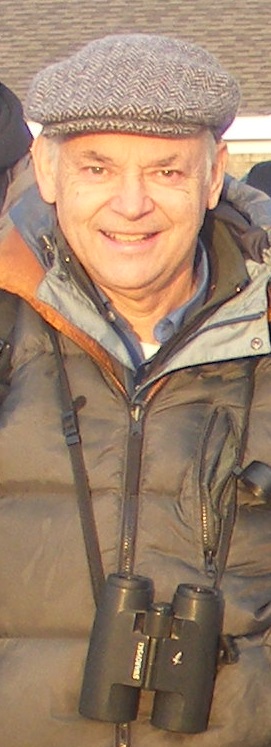
Richard “Dick” Ferren is one of the most accomplished ornithologists ever to work in RI. That he has not previously been recognized by the natural historical community is somewhat amazing. Ferren is a significant “bridge” figure in the continuum of RI ornithologists. In this continuum, Harry Hathaways’ career spanned from the “shooting era” to the “modern era” of observational records, and after him, the flag was taken up by Dave Emerson, Dick Bowen, Roland Clement, and Doug Kraus, among others. Right on their heels came Ferren. He was strongly influenced by these early figures and in turn influenced the next generation of observers, including me, Shai Mitra and Bob Emerson.
Dick has never been attracted to finding or listing rare species, but has rather appreciated, as he calls it, “the ever-changing tapestry” of bird populations. He grew up in East Providence and was attracted to birds at an early age; as a teenager he produced a monograph of the birds of the East Providence reservoir. He became active at the Norman Bird Sanctuary, where he was influenced by Jim Baird and others, and he participated in observational studies of diurnal migration (how birds move through the local landscape). This greatly influenced his worldview of birds. He spent many hours observing and counting oceanic migrants such as loons and scoters and also studied raptor migration along the Rhode Island coast, which is where I met him – watching hawks at Napatree Point. He began to participate in the Newport Christmas Bird Count when he was quite young, and never missed a year (60+ in a row).
In the 1970’s, Dick continued the early work of documenting RI’s colonies of sea birds and began the statewide surveys of Narragansett Bay with Jim Myers, which I continued after Myers retired. This work resulted in a nearly unbroken record of the nesting status of several gull, tern, and egret species. During the first Rhode Island Breeding Bird Atlas, Dick would spend days at a time, usually sleeping in his truck, probing the countryside to document (and count) nesting birds. He recognized that various physical parameters influenced the breeding densities of birds and his theories to account for this are still relevant today.
Dick’s biggest ornithological legacy will probably be his compilation of much historical material for his opus magnum manuscript of the Birds of Rhode Island. In this work, he summarized most of the historical material related to Rhode Island birds, including reading the original diaries of Elizabeth Dickens, Harry Hathaway, Maybelle Davenport, and others. The scope and detail of this work is virtually unprecedented for any local or regional bird text. He has an extensive library featuring many original manuscripts and other items from Rhode Island’s ornithological history. Dick has toiled away at documenting Rhode Island birds in relative obscurity, in part because he taught biology at Berkshire Community College and has lived in Massachusetts for several decades. He is, therefore, virtually unknown to the newest crop of observers. However, is it an even stronger testament to his commitment of Rhode Island birds that living in the Berkshires didn’t prevent him from making the 3-hour drive to Rhode Island to pursue his passions. There are few, if any, people who have pursued natural history with such intensity and passion or have made a larger contribution to Rhode Island natural history than Dick Ferren.